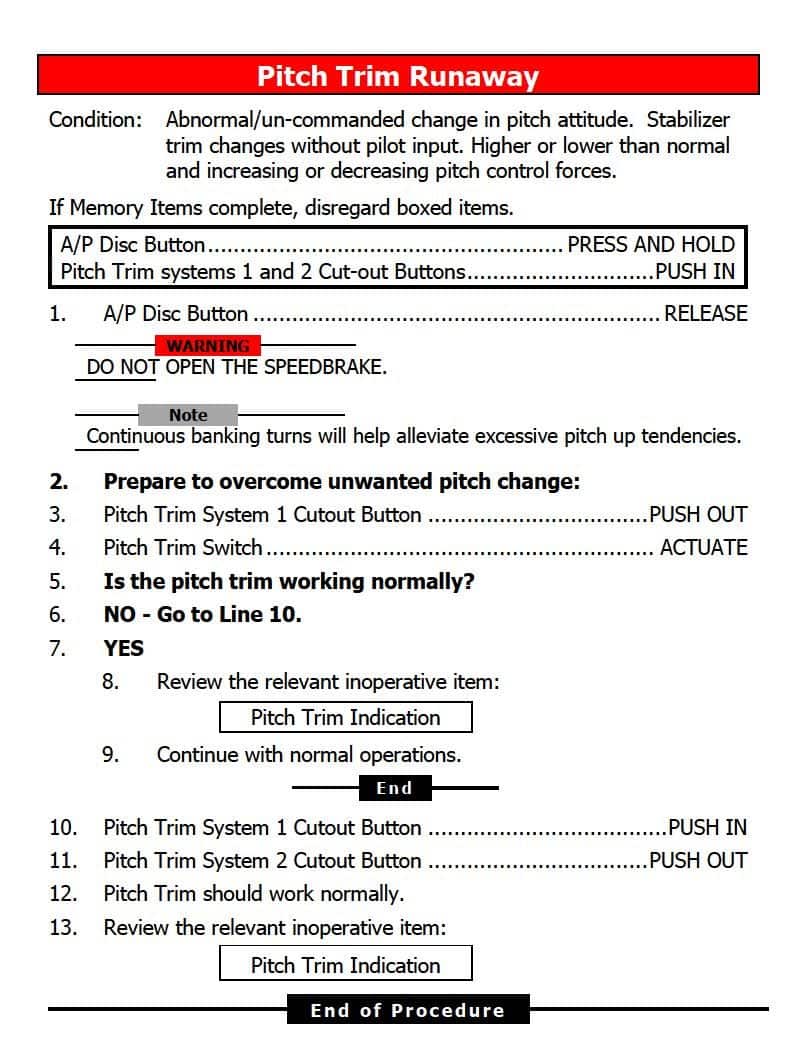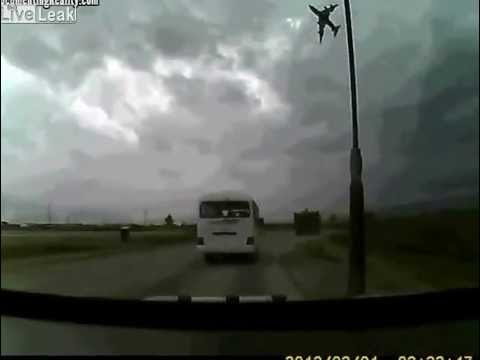Severe trim runaway E175 Republic Airways 11/6/19 Atlanta
Thread Starter
Join Date: Jul 2009
Location: France
Age: 62
Posts: 98
Likes: 0
Received 0 Likes
on
0 Posts
Severe trim runaway E175 Republic Airways 11/6/19 Atlanta
Incident: Republic E175 at Atlanta on Nov 6th 2019, trim runaway, severe control problems, stalling situation
A Republic Airways Embraer ERJ-175, registration N117HQ performing AA-4439 from Atlanta,GA to New York La Guardia,NY (USA) with 6 people on board, was climbing out of Atlanta's runway 09L when the crew declared emergency reporting they had a trim runaway, the crew stopped the climb at about 14,000 feet and positioned for a return to Atlanta's runway 10. The crew subsequently reported, while cleared for a right downwind to runway 10, they were in a stalling situation and subsequently added they couldn't get their pitch down, they were trying to descend nonetheless. ATC offered runway 08L, 10 or 09R, ATC could clear anyone out of the way. The crew advised they were able to take a turn and received vectors to runway 10. Instead of descending the aircraft began to climb again, then descended, the crew advised they got a system warning to cut out, got the problem under control and were now okay, they had been fighting with the aircraft for a while. The aircraft joined the final for runway 10, ATC again offered runway 10 or 09R, "your call", and cleared the aircraft to land either runway. The aircraft landed safely on runway 10 about 19 minutes after departure and about 15 minutes after the emergency call.
The aircraft is still on the ground about 18 hours after landing in Atlanta.
https://flightaware.com/live/flight/...204Z/KATL/KLGA
Great job by the crew. Sounds hairy.
A Republic Airways Embraer ERJ-175, registration N117HQ performing AA-4439 from Atlanta,GA to New York La Guardia,NY (USA) with 6 people on board, was climbing out of Atlanta's runway 09L when the crew declared emergency reporting they had a trim runaway, the crew stopped the climb at about 14,000 feet and positioned for a return to Atlanta's runway 10. The crew subsequently reported, while cleared for a right downwind to runway 10, they were in a stalling situation and subsequently added they couldn't get their pitch down, they were trying to descend nonetheless. ATC offered runway 08L, 10 or 09R, ATC could clear anyone out of the way. The crew advised they were able to take a turn and received vectors to runway 10. Instead of descending the aircraft began to climb again, then descended, the crew advised they got a system warning to cut out, got the problem under control and were now okay, they had been fighting with the aircraft for a while. The aircraft joined the final for runway 10, ATC again offered runway 10 or 09R, "your call", and cleared the aircraft to land either runway. The aircraft landed safely on runway 10 about 19 minutes after departure and about 15 minutes after the emergency call.
The aircraft is still on the ground about 18 hours after landing in Atlanta.
https://flightaware.com/live/flight/...204Z/KATL/KLGA
Great job by the crew. Sounds hairy.
Please don't flame a PPL with a question but if this happened in the Diamondstar I'd just pull the breaker and turn the trim wheel by hand. Can't that be done in an ERJ ?
Gender Faculty Specialist
So the main trim system may have a nose up runaway and as youíre fighting the airplane the backup trim takes twice as long.
Now this may or may not be the case with an Embraer as I know nothing about the plane systems.
Join Date: Jan 2008
Location: KMCO
Posts: 33
Likes: 0
Received 0 Likes
on
0 Posts
Last edited by NWstu; 8th Nov 2019 at 15:57. Reason: Had a bad link
It will be uncomfortable, but get it on its side and use rudder. Practiced this in training jets back in 1972. Same with the nose-down trim on the MAX, get it on its side. Uncomfortable, and the pax may see their breakfast again, but beats the alternative.
Join Date: Mar 2014
Location: United Kingdom
Posts: 106
Likes: 0
Received 0 Likes
on
0 Posts
Think this was muted to AA pilots in the 90ís though dealing with upset recovery.
Join Date: Mar 2019
Location: On the Ground
Posts: 155
Likes: 0
Received 0 Likes
on
0 Posts
Not QUITE as mad as doing it with excessive nose DOWN trim.
Might work if you rolled inverted, though. ;-)
Keep an eye on those oil pressure lights.
Same with the nose-down trim on the MAX, get it on its side.
Keep an eye on those oil pressure lights.
Last edited by Takwis; 9th Nov 2019 at 12:07.
"Mildly" Eccentric Stardriver
It will be uncomfortable, but get it on its side and use rudder. Practiced this in training jets back in 1972. Same with the nose-down trim on the MAX, get it on its side.
Join Date: Jun 2001
Location: Rockytop, Tennessee, USA
Posts: 5,898
Likes: 0
Received 1 Like
on
1 Post
In 2001 an A306 AA587 was departing JFK and got some wake turbulence from a 747 ahead. The FO did some rapid rudder kicks and the vertical stab sheared off the plane.
From the NTSB accident report:
7. The first officer had a tendency to overreact to wake turbulence by taking unnecessary actions, including making excessive control inputs.
8. The American Airlines Advanced Aircraft Maneuvering Program ground school training encouraged pilots to use rudder to assist with roll control during recovery from upsets, including wake turbulence.
9. The American Airlines Advanced Aircraft Maneuvering Program excessive bank angle simulator exercise could have caused the first officer to have an unrealistic and exaggerated view of the effects of wake turbulence; erroneously associate wake turbulence encounters with the need for aggressive roll upset recovery techniques; and develop control strategies that would produce a much different, and potentially surprising and confusing, response if performed during flight.
3.2 Probable Cause The National Transportation Safety Board determines that the probable cause of this accident was the in-flight separation of the vertical stabilizer as a result of the loads beyond ultimate design that were created by the first officerís unnecessary and excessive rudder pedal inputs. Contributing to these rudder pedal inputs were characteristics of the Airbus A300-600 rudder system design and elements of the American Airlines Advanced Aircraft Maneuvering Program.
8. The American Airlines Advanced Aircraft Maneuvering Program ground school training encouraged pilots to use rudder to assist with roll control during recovery from upsets, including wake turbulence.
9. The American Airlines Advanced Aircraft Maneuvering Program excessive bank angle simulator exercise could have caused the first officer to have an unrealistic and exaggerated view of the effects of wake turbulence; erroneously associate wake turbulence encounters with the need for aggressive roll upset recovery techniques; and develop control strategies that would produce a much different, and potentially surprising and confusing, response if performed during flight.
3.2 Probable Cause The National Transportation Safety Board determines that the probable cause of this accident was the in-flight separation of the vertical stabilizer as a result of the loads beyond ultimate design that were created by the first officerís unnecessary and excessive rudder pedal inputs. Contributing to these rudder pedal inputs were characteristics of the Airbus A300-600 rudder system design and elements of the American Airlines Advanced Aircraft Maneuvering Program.
With runaway nose down trim you would toll the aircraft on its side? You kid right?
A full 90į bank in a transport aircraft? Not on my life. Not without a full understanding of a given aircraft's inertia, control response, rudder effectiveness, W&B etc.
But - see the note in the procedure posted by barrow
Some bank will A) spill some excessive pitch-up into turning moment, and B) turn the VS and rudder into an angled "half-ruddervator" as in a fork-tailed Bonanza, allowing some minor pitch adjustment via the rudder pedals (at the cost of a slip or skip).
It will require fine judgement if one is already in a near-stall attitude, since the banked turn will increase effective weight (G forces). Conversely, being able to input partial "bottom-rudder" with the pedals may help reduce AoA.
And it's still only a stopgap until the rest of the procedure can be completed successfully and normal control regained in all axes. One would have only a bit more long-term course control than the DC-10 at Sioux City - flying in circles or steepish S-turns all the way to the runway.
But - see the note in the procedure posted by barrow
NOTE: Continuous banking turns will help alleviate excessive pitch up tendencies.
It will require fine judgement if one is already in a near-stall attitude, since the banked turn will increase effective weight (G forces). Conversely, being able to input partial "bottom-rudder" with the pedals may help reduce AoA.
And it's still only a stopgap until the rest of the procedure can be completed successfully and normal control regained in all axes. One would have only a bit more long-term course control than the DC-10 at Sioux City - flying in circles or steepish S-turns all the way to the runway.
Join Date: Apr 2019
Location: Toronto
Posts: 20
Likes: 0
Received 0 Likes
on
0 Posts
This checklist assumes that at least one of the pitch trim systems will function normally. The steps are to figure out which one is the good one.
In the ATC recording the pilot says that they have cut out system 1 and 2, so what are they using?
In the ATC recording the pilot says that they have cut out system 1 and 2, so what are they using?





